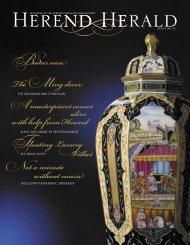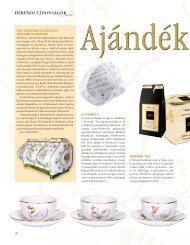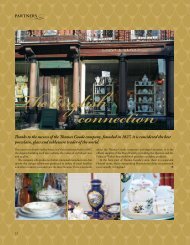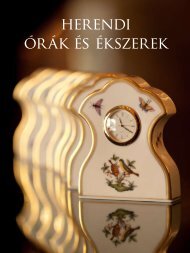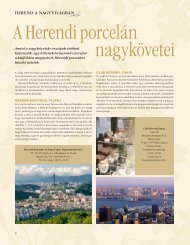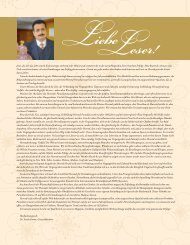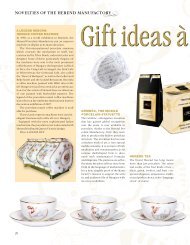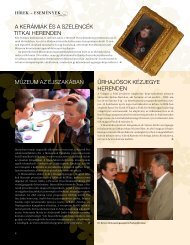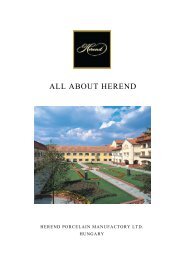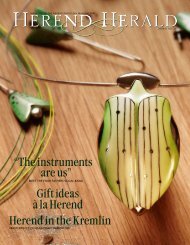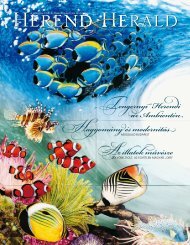LA PORCELAINE DE HEREND HEREND PORCELAIN
Genfi_32 q:Layout 1
Genfi_32 q:Layout 1
You also want an ePaper? Increase the reach of your titles
YUMPU automatically turns print PDFs into web optimized ePapers that Google loves.
Gabriella Balla<br />
Conservateur au Musée des arts<br />
appliqués, Budapest<br />
Gabriella Balla<br />
Curator at the Museum of Applied Arts,<br />
Budapest<br />
La Manufacture de Herend<br />
The Herend Manufactory<br />
6 Cette exposition n’aurait pas eu le même éclat sans les<br />
œuvres de qualité que le Musée des arts décoratifs de<br />
Budapest a bien voulu nous confier temporairement,<br />
nous en sommes profondément reconnaissants à sa<br />
directrice, M me Zsuzsanna Renner, ainsi qu’à M. Zsombor<br />
Jékely, responsable de la recherche et des expositions.<br />
La majorité des œuvres nous ont été généreusement<br />
prêtées par le Musée de la porcelaine de Herend et par<br />
la Manufacture de Herend, laquelle nous a également<br />
fourni un appréciable soutien logistique. Notre vive reconnaissance<br />
va à MM. Attila Simon, directeur général<br />
de la Manufacture de Herend; László Szesztay, directeur<br />
commercial; Endre Körös, président du Conseil de la<br />
fondation du Musée de la porcelaine de Herend, ainsi<br />
qu’à leurs collaborateurs.<br />
Nous remercions chaleureusement M. László Szathmáry,<br />
de la Manufacture de Herend, qui a assumé avec compétence<br />
et enthousiasme la lourde tâche de coordinateur<br />
en Hongrie pour l’organisation de l’exposition et pour la<br />
production du présent ouvrage. Un merci tout particulier<br />
également à Monika Rudolf-Schmidt. Sans son initiative<br />
et sans son assistance efficace et amicale, Herend n’aurait<br />
peut-être pas trouvé le chemin de Genève!<br />
The majority of the pieces have been generously lent to<br />
us by the Herend Porcelain Museum and by the Herend<br />
Porcelain Manufactory, which also gave us appreciable<br />
logistic support. Deep gratitude is due to Mr Attila<br />
Simon, the General Director of the Manufactory; Mr<br />
László Szesztay, the Commercial Director; Mr Endre<br />
Körös, President of the Foundation of the Herend Porcelain<br />
Museum, and their colleagues.<br />
We warmly thank Mr László Szathmáry of the Herend<br />
Manufactory, who with skill and enthusiasm undertook<br />
the heavy task of coordinator in Hungary for the organisation<br />
of the exhibition and the production of this book.<br />
Very particular thanks also go to Monika Rudolf-Schmidt.<br />
Without her initiative and her efficient and friendly<br />
assistance, Herend might not have found the way to<br />
Geneva!<br />
The original version of the small ornamental vase with<br />
a lid glittering as a jewel was made in 1856, and<br />
today it is kept in the Museum of Applied Arts. The<br />
gilded handle of the richly coloured lid of the vase s<br />
shaped like a Lion of Fo. Underneath it, fighting<br />
green- and red-scaled dragons appear amongst<br />
turquoise and green clouds; the back and the front<br />
panels have two larger paintings each representing<br />
the life of Chinese aristocracyThe original version of<br />
the small ornamental vase with a lid glittering as a<br />
jewel was made in 1856, and today it is kept in the<br />
Museum of Applied Arts. The gilded handle of the<br />
richly coloured lid of the vase s shaped like a Lion of<br />
Fo. Underneath it, fighting green- and red-scaled<br />
dragons appear amongst turquoise and green clouds;<br />
the back and the front panels have two larger paintings<br />
each representing the life of Chinese aristocracyvThe<br />
original version of the small ornamental vase<br />
with a lid glittering as a jewel was made in 1856, and<br />
today it is kept in the Museum of Applied Arts. The<br />
gilded handle of the richly coloured lid of the vase s<br />
shaped like a Lion of Fo. Underneath it, fighting<br />
green- and red-scaled dragons appear amongst<br />
turquoise and green clouds; the back and the front<br />
panels have two larger paintings each representing<br />
the life of Chinese aristocracyThe original version of<br />
the small ornamental vase with a lid glittering as a<br />
jewel was made in 1856, and today it is kept in the<br />
Museum of Applied Arts. The gilded handle of the<br />
richly coloured lid of the vase s shaped like a Lion of<br />
Fo. Underneath it, fighting green- and red-scaled<br />
dragons appear amongst turquoise and green clouds;<br />
the back and the front panels have two larger paintings<br />
each representing the life of Chinese aristocracyThe<br />
original version of the small ornamental vase<br />
with a lid glittering as a jewel was made in 1856, and<br />
today it is kept in the Museum of Applied Arts. The<br />
gilded handle of the richly coloured lid of the vase s<br />
shaped like a Lion of Fo. Underneath it, fighting<br />
green- and red-scaled dragons appear amongst<br />
turquoise and green clouds; the back and the front<br />
panels have two larger paintings each representing<br />
the life of Chinese aristocracy haped like a Lion of Fo.<br />
Underneath it, fighting green- and red-scaled dragons<br />
appear amongst turquoise and green clouds; the back<br />
and the front panels have two larger paintings each<br />
representing the life of Chinese aristocracy<br />
Chapters from the history of Hungarian ceramic<br />
The medieval kingdom of Hungary – in the time of the<br />
Árpád kings, Robert Charles, Louis the Great, Sigismund<br />
of Luxembourg and Matthias – was a major power in<br />
Europe. Throughout the Middle Ages, the kingdom<br />
maintained extensive commercial and cultural contacts<br />
with both western and eastern Europe and the Mediterranean.<br />
In this period and during the Renaissance, the<br />
stock of luxurious household goods owned by the court<br />
almost certainly included a few examples of fine cera -<br />
mics. A new technique in the art of ceramics, tin glazing,<br />
emerged in Italy in the 15 th century, and later in the<br />
hands of Italian potters it developed into a much admired<br />
art. The Hungarian royal couple – Matthias Corvinus and<br />
his wife, Beatrice of Aragon, were among the first European<br />
rulers to receive decorative platters adorned with<br />
their coat of arms, allegorical depictions, and figural and<br />
ornamental painting. Once thought to have been made<br />
in Faenza, these dishes – parts of the Corvinus-service –<br />
were most likely presented by the prince of Pesaro,<br />
Costanzo Sforza, and his wife, Camille of Aragon. The<br />
court of Matthias Corvinus was thus one of the first<br />
recipients of Italian majolica beyond the Alps. Under the<br />
direction of Italian masters, majolica workshops even<br />
operated in Buda. The tin-glazed floor tiles painted with<br />
the emblems of Matthias and the house of Aragon were<br />
used primarily to decorate the rooms of the royal palace<br />
in Buda. Art of the Matthias period continued to impact<br />
Hungarian art and culture for centuries. The centralized<br />
power of the Hungarian Kingdom, however, crumbled<br />
several decades after Matthias’ death as a result of<br />
repeated attacks by the conquering Ottoman Turkish<br />
forces. The Hungarian troops suffered serious losses at<br />
the battle of Mohács (1526), and later with the fall of<br />
Buda (1541) the country was divided into three parts.<br />
The eastern part comprised the independent principality<br />
of Transylvania, the central region was under Turkish rule,<br />
while the north-western area remained as the surviving<br />
Kingdom of Hungary under Habsburg rule. Turkish occupation<br />
lasted a century and a half, and the towns and<br />
villages of the central region were depopulated. Never -<br />
theless, the ceramic art of this period was rich, and<br />
exported Turkish ware – especially the art of Iznik – had<br />
a powerful influence on the repertoire of motifs used in<br />
Hungary. A Turkish-Persian element in the decoration of<br />
17 th century Haban pottery, which at first relied mainly<br />
on Faentine motifs, became increasingly common. The<br />
Hungarian aristocracy highly regarded this white dishware,<br />
the so-called bianchi di Faenza, and numerous<br />
inventories list this kind of dishware along with Turkish<br />
rugs and silverworks. The Haban workshops produced<br />
not only gallantly simple tableware (teapots, lids, bottles,<br />
platters, bowls and fingerbowls) painted with cobalt,<br />
antimony, bronze oxide and manganese, displaying the<br />
year, the patron’s monogram and occasionally his name,<br />
but also stove tiles used to build large columnar stoves<br />
with decorative mouldings. Porcelain appeared less<br />
frequently on stock lists in 17 th century Hungary than in<br />
European territories west of the River Leitha. Rare Chinese<br />
porcelains set in precious metals were considered<br />
7



